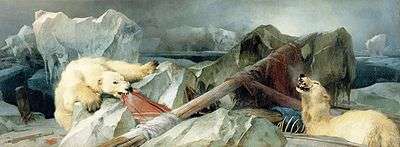Man Proposes, God Disposes
 | |
| Artist | Edwin Henry Landseer |
|---|---|
| Year | 1864 |
| Dimensions | 91.4 cm × 243.7 cm (36.0 in × 95.9 in) |
| Location | Royal Holloway College |
Man Proposes, God Disposes is an 1864 oil-on-canvas painting by Edwin Henry Landseer. The work was inspired by the search for Franklin's lost expedition which disappeared in the Arctic after 1845. The painting is in the collection of Royal Holloway, University of London.
Background
The painting depicts an imagined Arctic scene in the aftermath of Sir John Franklin's expedition in 1845 to explore the Northwest Passage.
The 134 men of Franklin's exhibition left Greenhithe in May 1845 on two steam-powered ironclad icebreakers, HMS Erebus and HMS Terror. After five left the ship, the remaining 129 men were last seen by a whaling vessel in Lancaster Sound in July 1845, but then disappeared without trace into the ice. The expedition was well-provisioned for a voyage of several years, but eventually, search parties were sent out as time passed and no further sightings were made. In 1854, Inuit recounted tales of sightings in 1850 to Captain John Rae of the Hudson's Bay Company, and he found some dead bodies on King William Island. Rae also reported suspicions of cannibalism among the last survivors.
In 1859, Francis Leopold McClintock published The Voyage of the Fox in the Arctic Seas, an account of his voyage on the Fox in search of Franklin from 1857 to 1859, and his discovery of the remains of two crew from Erebus on King William Island earlier in 1859, together with the ship's boat and other detritus.
The painting may also have been inspired by Caspar David Friedrich's 1824 painting The Sea of Ice, and Frederic Edwin Church's The Icebergs, which was first exhibited in New York in 1861 and shown in London in 1863.
Description
The painting adopts the dark tones of Landseer's later works. The scene shows two polar bears among the scattered wreckage of the expedition - a telescope, the tattered remains of a red ensign, a sail, and human bones, which William Michael Rossetti called "the saddest of membra disjecta". The image shows humanity and civilization defeated by "nature, red in tooth and claw", and can be seen as a commentary on the crisis of British triumphalism and imperialism in the middle of the 19th century.
The phrase "Man proposes, but God disposes" is a translation of the Latin phrase "Homo proponit, sed Deus disponit" from Book I, chapter 19, of The Imitation of Christ by the German cleric Thomas à Kempis.
Reception
The painting was exhibited at the 1864 Royal Academy summer exhibition. Lady Franklin was invited to the exhibition, but avoided the "offensive" painting.
The Art Journal described its "poetry, pathos, and terror " and "tragic grandeur", the Athenaeum noted an "epic" quality, and the Saturday Review praised its "sublimity of sentiment".
The painting was sold at auction to Thomas Holloway in 1881, and currently hangs in the picture gallery of Royal Holloway, University of London, where examinations are held. It is a college tradition to cover the painting with a union flag when exams are held in the gallery, as a longstanding rumour since at least the 1970s has it that the painting drives people mad when they sit by it.
References
- The Arctic Fantasies of Edwin Landseer and Briton Riviere: Polar Bears, Wilderness and Notions of the Sublime, Diana Donald. Tate Papers Issue 13, 1 April 2010 .
- "The cravings of nature": Landseer’s Man Proposes, God Disposes and the Franklin Expedition, Sophie Gilmartin, Royal Holloway, 2008 ()
- Edwin Landseer, Man Proposes, God Disposes, 1864, Laura MacCulloch, Royal Holloway, May 2013
- Sir Edwin Landseer's Man Proposes, God Disposes: And the fate of Franklin, Andrew Moore, The British Art Journal, Vol. 9, No. 3 (Spring 2009), pp. 32-37
- The painting reputed to make students fail exams, BBC News magazine, 13 September 2014